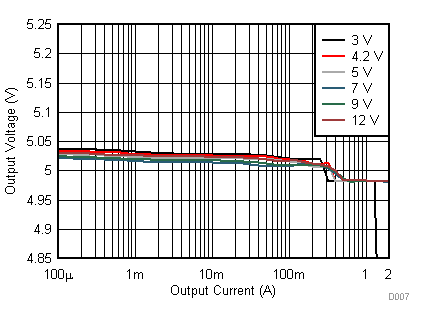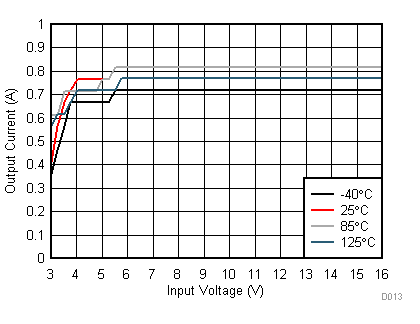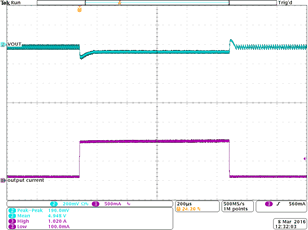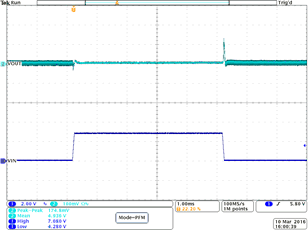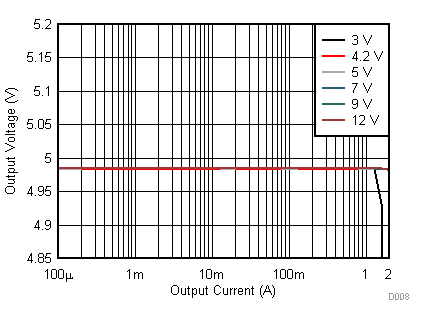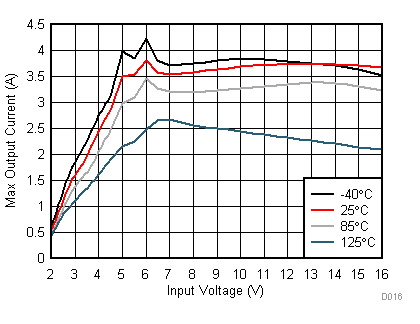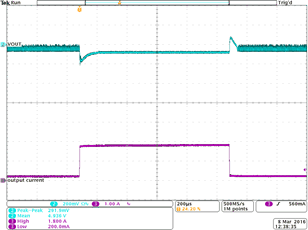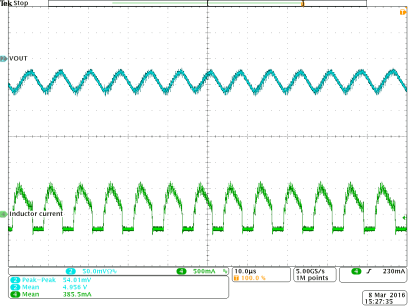| Efficiency |
| Efficiency vs Output Current (PFM/PWM) |
VIN = 3 V, 4.2 V, 5 V, 7 V, 9 V, 12 V, VOUT = 5 V , PS/SYNC = Low |
Figure 38 |
| Efficiency vs Output Current (PWM only) |
VIN = 3 V, 4.2 V, 5 V, 7 V, 9 V, 12 V, VOUT = 5 V , PS/SYNC = High |
Figure 39 |
| Load Regulation |
| Load Regulation, PFM/PWM Operation |
VIN = 3 V, 4.2 V, 5 V, 7 V, 9 V, 12 V, VOUT = 5 V , PS/SYNC = Low |
Figure 40 |
| Load Regulation, PWM Operation |
VIN = 3 V, 4.2 V, 5 V, 7 V, 9 V, 12 V, VOUT = 5 V , PS/SYNC = High |
Figure 41 |
| Output Current |
| Typical Start-up Current vs Input Voltage |
VOUT = 5 V, TJ = -40 °C, 25 °C, 85 °C, 125 °C |
Figure 42 |
| Maximum Load Current vs Input Voltage |
VOUT = 5 V, TJ = -40 °C, 25 °C, 85 °C, 125 °C, PG = high |
Figure 43 |
| Regulation Accuracy |
| Load Transient, PFM/PWM Boost Operation |
VIN = 4.2 V, VOUT = 5 V, Load = 100 mA to 1 A, PS/SYNC = Low |
Figure 44 |
| Load Transient, PFM/PWM Buck Operation |
VIN = 12 V, VOUT = 5 V, Load = 200 mA to 1.8 A, PS/SYNC = Low |
Figure 45 |
| Line Transient, PFM/PWM Operation |
VIN = 4.2 V to 7 V, VOUT = 5 V, Load = 1 A, PS/SYNC = Low |
Figure 46 |
| Output Voltage Ripple |
| Output Voltage Ripple, PFM/PWM Operation |
VIN = 4.2 V, VOUT = 5 V, Load = 0.3 A, PS/SYNC = Low |
Figure 47 |
| Output Voltage Ripple, PWM Operation |
VIN = 4.2 V, VOUT = 5 V, Load = 1 A, PS/SYNC = high |
Figure 48 |
| Output Voltage Ripple, PFM/PWM Operation |
VIN = 7.2 V, VOUT = 5 V, Load = 0.3 A, PS/SYNC = Low |
Figure 49 |
| Startup |
| Start-up Behavior from Rising Enable, PFM/PWM Operation |
VIN = 4.5 V, VOUT = 5 V, Load = 0.5 A, PS/SYNC = Low |
Figure 50 |

